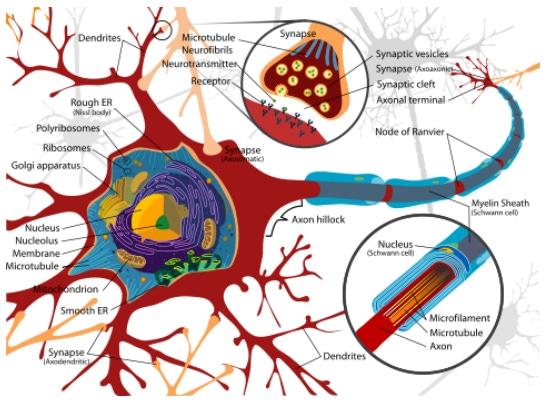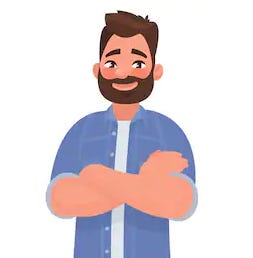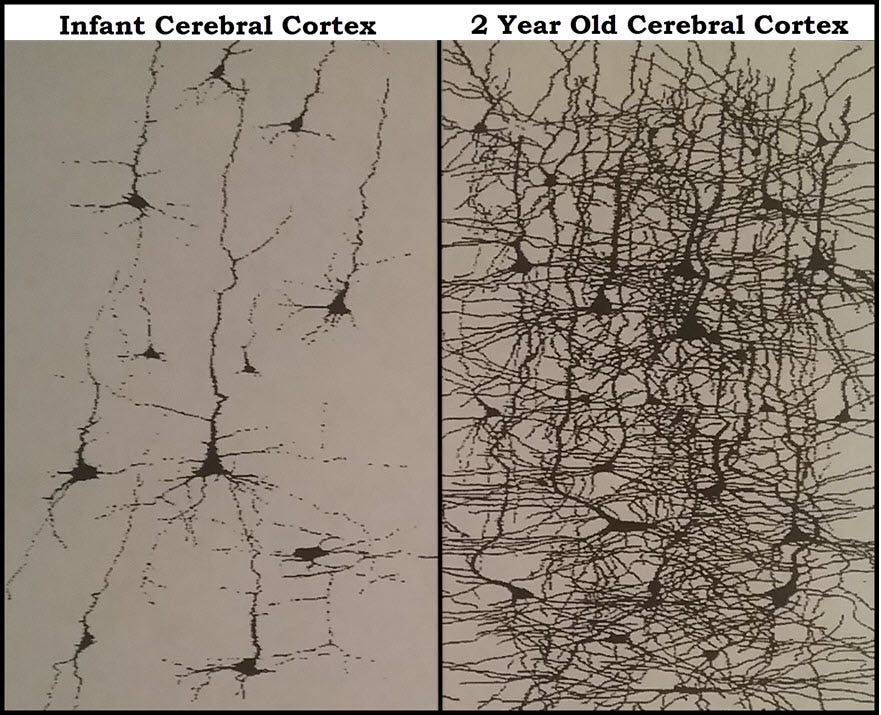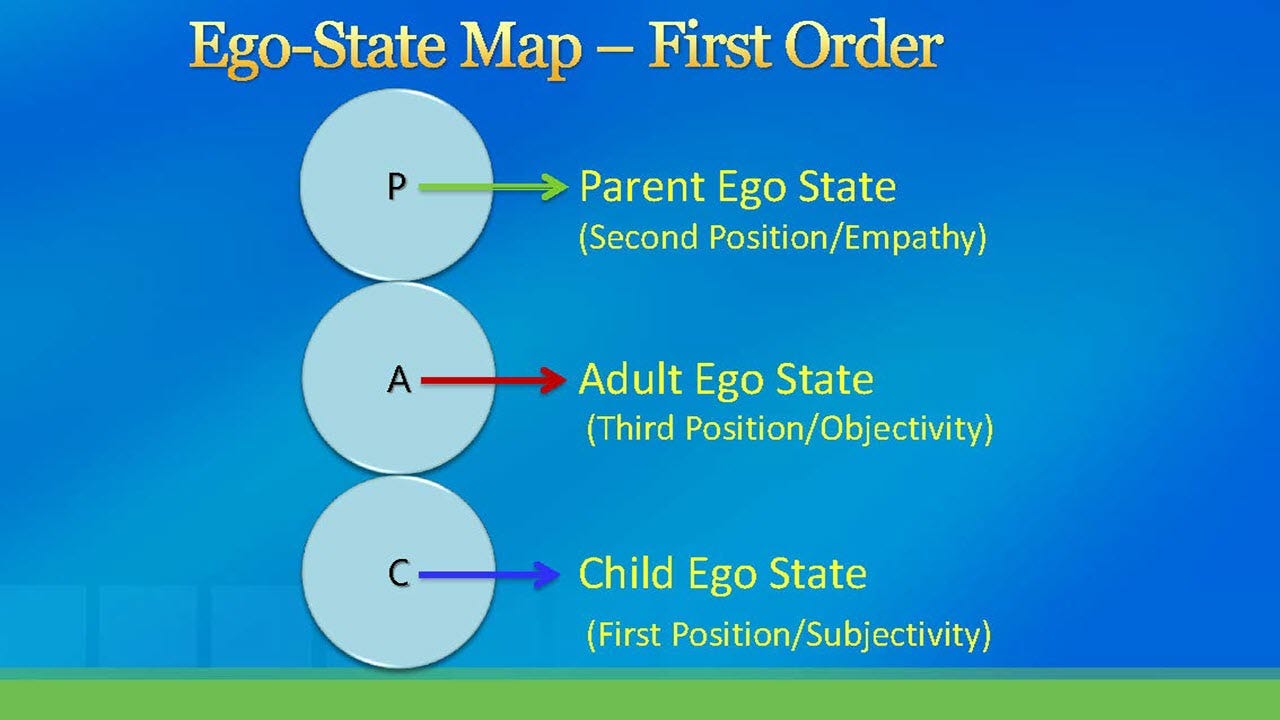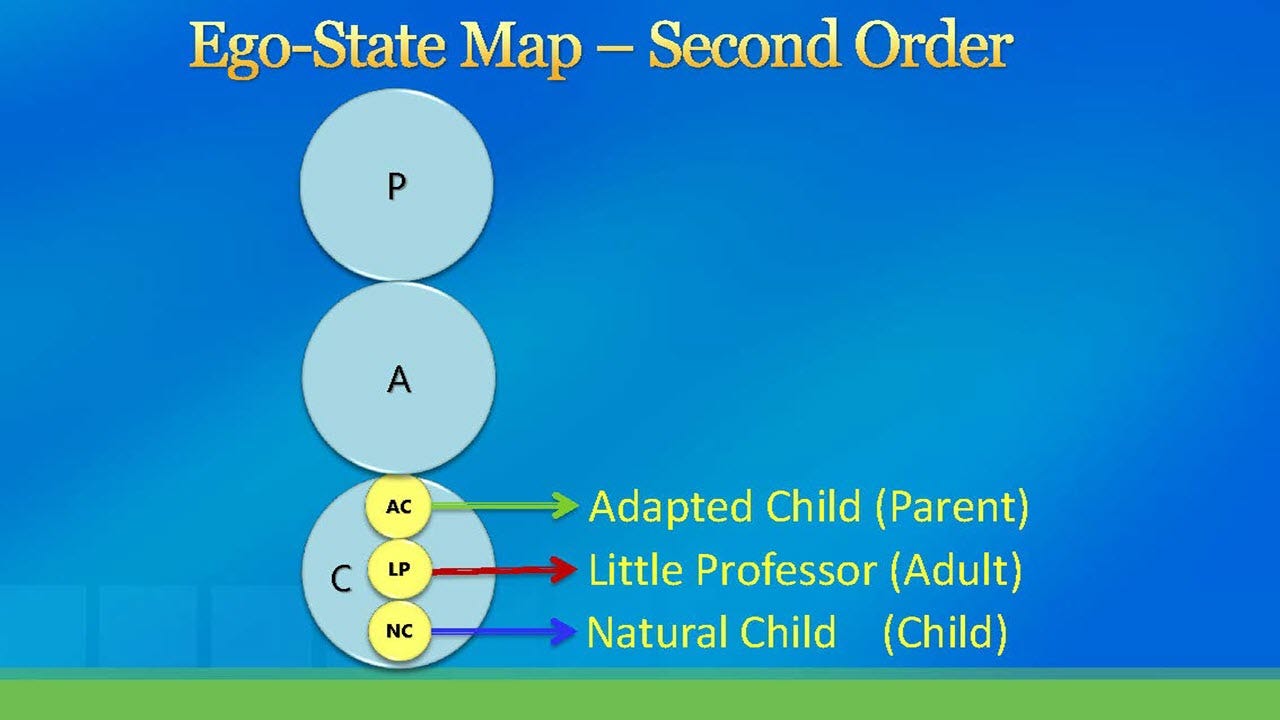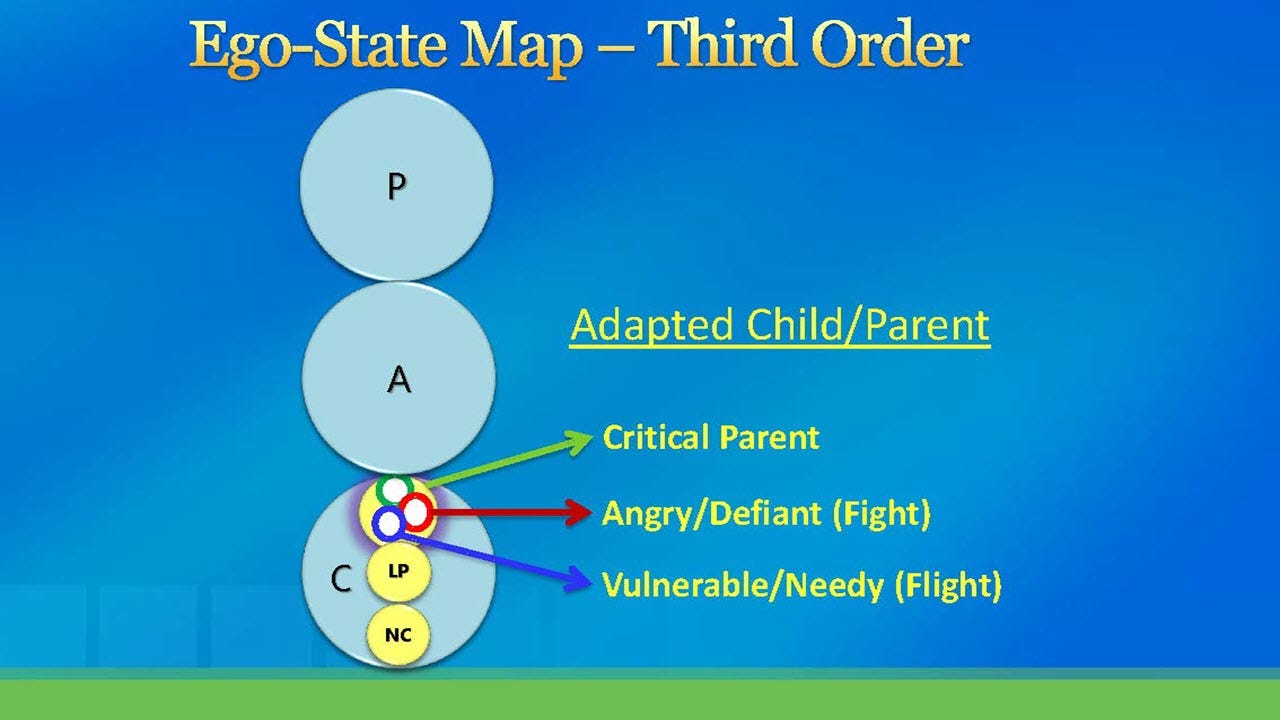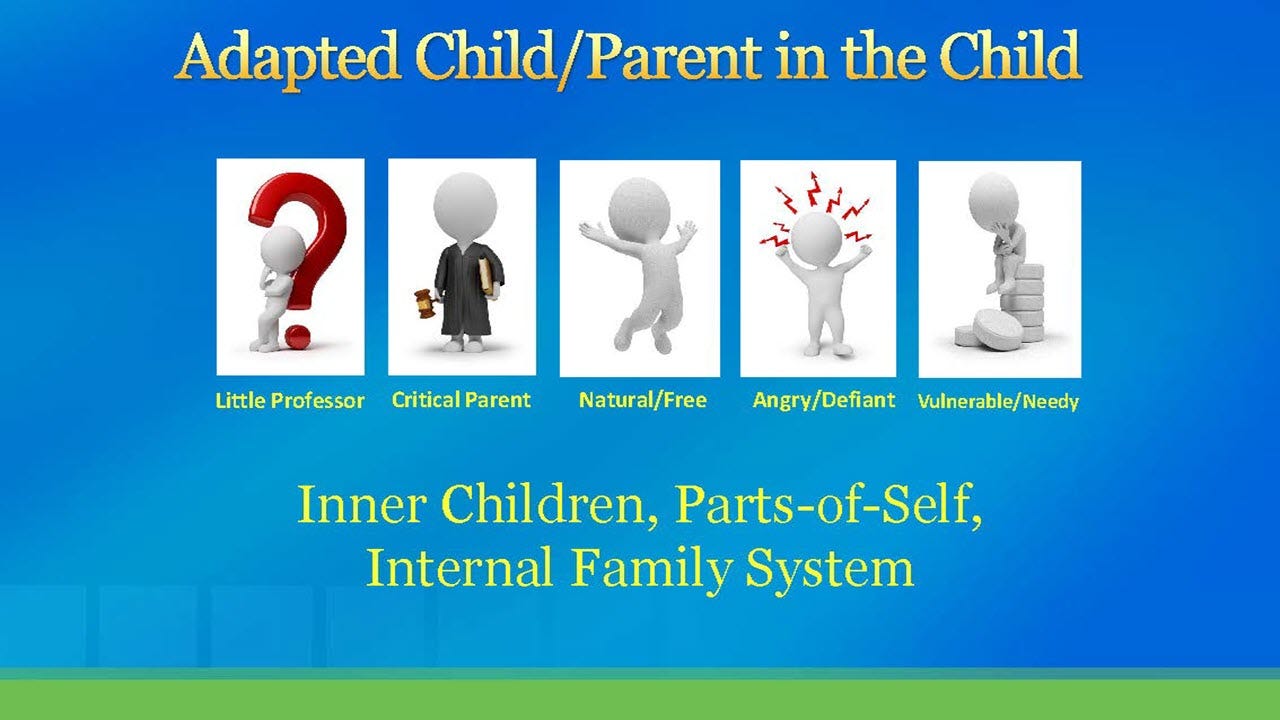Ego States Maps
The three primary Ego-States of TA are the Parent Ego-State, The Adult Ego-State, and the Child Ego-State. The First Order Map is the Model used in the Functional Ego-State Map (Functional and Dysfunctional Parts of Self).
Watch the video above or read the transcript below to learn more about second and third-order ego-state maps.
Ego-State therapy paved the way for many other "Parts-Oriented" therapies including Internal Family Systems (IFS) Therapy and Parts Integration Therapies. Gestalt therapy also plays a major role in the evolution of this therapeutic orientation.
Video Transcript
In order to understand the concept of ego States, we need to understand a little bit about how the brain works. We'll start with this image of a brain cell or neuron. There are trillions of these neurons in the mind and body. They are supercomputers, and you can see that they have many connections with many other areas of the brain.
Dendrites will take in an electrical chemical signal from other neurons, deliver it to the cell body, where a neural chemical will be manufactured. And with another electrical chemical impulse, that neurotransmitter will be sent down the Axon. The Axon then delivers the new neural transmitter to the next neuron via the dendrite connection, which is really actually a gap between one and the other called the synapse. So you can think of the Axon as the teacher and the dendrite as a student. There can be as many as 100,000 dendrites connecting to one neuron.
It's been estimated that there are more ways to connect the neurons in the brain than there are atoms in the universe. But all the neurons in the brain are not connected to each other. There are networks of neurons embedded in networks of neurons embedded in networks of neurons, and so forth. You may recognize this structure as something that we call the Internet. The internet is a huge network of computers consisting of networks of computers embedded in networks of computers embedded in networks of computers, and so on.
Neural Network Demonstration
However, the internet of the mind is much more complex and sophisticated than the internet of the world. A network of neurons in our brain can be referred to as a neural network. When we learn something new, it becomes encoded on a neural network. Let me show you how this works. Cross your arms in front of you, however you normally do.
Now take a really close look at how you have them crossed. Notice whether one hand is under or over and which arm is on top. Now try to do it exactly the opposite way.
Yeah. You may have noticed a momentary brain freeze. And even if you are able to cross your arms exactly the opposite way, it doesn't feel right, does it? The brain freeze happens because we don't have a neural network for crossing our arms the opposite way. We have to shift from right brain thinking, which is automatic and programmed as a neural network, over to left brain thinking so we can teach ourselves how to cross our arms the opposite way.
And even if we do manage to do it, it doesn't feel right because the mind and body adapt to the way we are used to doing it through that neural network. So we have everything we've ever learned in our life encoded on neural networks in our brain. The neural networks embedded in other neural networks comprise a vast neural matrix of networks embedded in networks embedded in networks, and so on. We have small networks encoding information, such as how to tie your shoe to very large and sophisticated networks for such things as how to do a relationship, how to do my job, how to do many other specialized things. The slide on synaptic pruning shows an infant's cerebral cortex neural circuitry shortly after birth on the left and the same child two years later on the right.
We can see the density of the neural circuitry has exploded over those first two years of life. A large majority of those connections have become obsolete because the child has grown beyond the need to use them nursing, for example but that child has a lot of learning left to do. Synaptic pruning involves the elimination of unused connections and the creation of new connections. This process of synaptic pruning continues throughout the course of our life. That's the good news.
We now know that the brain is not hard-wired. The term neuroplasticity highlights that the brain can change its structure in the same way. The plastic can be molded and remolded. Every 15 minutes that we are learning something new, we are either growing a new dendrite connection or recruiting unused connections for new networks. This is called neurogenesis or brain growth.
When we talk about chronic stress later on, we'll talk about the impact that has on neurogenesis. It's not good in that being triggered into survival mode shuts down brain growth or neurogenesis, and diverts all of our energy into survival and coping with those perceived threats.
First Order Ego-State Map
But our purpose here is to learn enough about neural networks to set up a discussion about ego States or parts of self. So what are ego States? You probably already guessed it. Ego States or parts of self are parts of our personality that are encoded on specific neural circuitry in the brain and body. In transactional analysis, there are three primary neural networks for our personality the parent, the adult, and the child.
The parent ego state has two jobs to nurture and protect loved ones, primarily our children. They do this from second perceptual position. Second position is all about others what they want, what they need, and what they feel. Healthy use of second position is called empathy. The position offers much flexibility when involved in a conflict with another person.
It's also extremely valuable for deepening rapport with others. So to be in second position means stepping into the other person's shoes, taking into account how an event or communication would look, feel, and sound from the other person's point of view, as if you're actually using their eyes and their ears associating into their body. Imagine that you are entering that other person's body in this position, and you can imagine looking at yourself through their eyes. What would you look like sound like, and what feelings would you get from the other person's view point of view?
The adult ego state is oriented in the present and can be comparable to a computer. I like to call it the CEO of the Self because it's responsible for executive functioning activities such as decision making, problem solving, planning, getting the job done, and so forth. The adult is organized, adaptable, and intelligent. It knows the history of the organization and the vision for the future. And it functions by testing reality, eliminating possibilities, making choices, dispassionately unencumbered by emotion.
The adult operates from third perceptual position like a curious bystander seeing everything from a distance and making objective decisions based on sound thinking and objectivity. Healthy use of third position is called objectivity or, in Alanon terms, it's referred to as detachment when used in a healthy way, such as emotionally detaching from dysfunctional behavior like those of the Drama Triangle. Third position is a good position from which to study yourself and your relationships. Think of it like being a bird in the corner of the room watching those two down there, or an innocent bystander watching those two strangers over there with curiosity. The child ego state contains all the impulses that come naturally to a child.
The child is creative adventuresome, spontaneous, curious, affectionate, and so on. The child loves to giggle and laugh, have fun, and enjoy the simple things in life. It can be a brat or wine when it doesn't get its way. The child lives in first person. When you associate into your own body, you are in first perceptual position.
You look, feel, and hear the world from your own viewpoint. In first position, you do not take into account anyone else's position. You simply think, how does this conversation or communication affect me? Healthy use of first position is called subjectivity or self awareness. It's the position that I must take in order to discover what I want, what I need and what I feel, who I am in this situation or this relationship.
Second Order Ego-State Map
The Second Order Structural Ego State map shows the parent, adult, and child in the adult and the parent, adult, and child in the child. Anyone who's ever watched a five year old play with a doll or push a baby buggy has seen the parent and the child. Kids integrate their learning through play and emulation. They pretend to be Mummy or Daddy in order to begin Populating neural circuitry on how to be Mommy or Daddy. So the parents and the child takes in all the parenting.
It gets all the shoulds and all the musts and all the Otis delivered by the parents and other authority figures such as school or Church or in the neighborhood. This is the socialized part of the child that learns the how to dad shows us how men are in the world, and mom shows us how women are together. They show us how men and women get along and do relationships. In the early days of transactional analysis, the adult in the adult was called the Big Professor and the adult and the child was called the Little Professor. That name stuck to this day.
The Little Professor is the smart little kid in each of us that figures out how to get what we want, how to get what we need, even when it's not okay to ask. It can be manipulative if that's what it takes to get what we need. The little professor is actually the subconscious mind of a child. The adult has life experience. The child does not, but it does have creativity, ingenuity, instinct, and intuition.
The natural, fun loving child is also known as the free child. It's unencumbered by rules and what other people think. It's the part of south that can become the kid in a candy store without parental supervision. Later on becoming the addict or alcoholic.
Third Oder Ego-State Map
The adapted child is the instinctive level ego state map or third order ego state map. It's the network locations of all the accumulated trauma. Here we have ego States, embedded in ego States, embedded in ego States. There are three main parts in the adapted child, the critical parent, the angry, defiant child, and the vulnerable needy child. Since it's the instinctive level, this is where the fight or flight response occurs.
The angry, defiant child, of course, is the fight response, and the vulnerable needy child is the flight response that's their jobs at the instinctive level. But later on in a healthy adult, the angry, defiant and vulnerable needy child have some very sophisticated jobs to do. The angry, defiant child brings enough energy to say no and set healthy boundaries. The vulnerable needy child brings enough vulnerability to let the walls down and let someone in so they can connect. But when we grow up in a less than nurturing family, there's trauma, either on a mild, moderate, or severe level.
When that occurs, the critical parent ego state contains all the critical parent messages given to that child, all the shoulds and the must and the Otto's. Some of them are good like you should look both ways before you cross the street, but others are not so good or helpful, such as you should never trust. Women or men are never to be trusted. The younger a child is, the more receptive they are to these messages referred to as parental injunction in ta language. The angry, defiant child is the neural network for the eight to twelve year old part of us that contains all the thoughts, feelings, and attitudes, all the coping styles of that time in our lives.
We may see the angry, defiant child begin to emerge in the emotional birth, which is called the terrible twos, when temper tantrums become another way of getting what we want. But the era of the angry, defiant child begins in puberty and carries on into adolescence. The vulnerable needy child is the ego state of the one to seven year old part of us that carries all the abandonment, shame, content, and trauma from our childhood. These are the reactive, wounded parts of self that we'll be talking about in further episodes. So listen to this audio a few times until you feel like you have a really basic understanding of the concept of ego States and parts of self and look at the pictures on the last slide to remind yourself of child created ego state.
Child-Created Ego-States
Ego-State Projection Exercise
When you're ready, take a moment to sit quietly in a room and imagine that all five of your child created ego States are going to come into the room and join you one at a time but they're going to come in on their own terms. You don't decide which one comes in first you just tune into your intuition. Let them venture forth as they will using only your imagination and your intuition. Notice which part would be the first one to come into the room. Where would it sit or stand?
How old does it look? What facial expression and body posture do you notice? How do you feel toward that part of yourself? Do you like it or not like it?
Write these things down in your Journal. Just begin getting to know these parts of self and building a little rapport and connection. When you do the ego state projection exercise later on these notes will come in handy. One final thought when you the adult are talking to an inner child part or a younger part of self then your left brain is talking to some other part of your right brain and in order to do that it has to open up a channel. We call that a neural pathway or a neural connection connecting one neural network on one side of the brain with another neural network on the other side of the brain.
This exercise, when with intensity and repetition, actually makes biological changes in the brain that connect neural networks together for the first time. We call that integration and it's a prime goal of therapy.


